1
Shoot the Dancer – Photography and Dancesport: Deep Focus.
Text: Helmut Römhild Photography and Diagrams: Helmut Römhild
The main target of the dancesport photographer is the pair of dancers performing in a tournament.
A common practice to catch moving ballroom dancers is to shoot from a corner along either the ballroom’s diagonal or one of the long sides of the floor,
thus letting the dancers move towards the camera.
These are the main advantages:
| • | The movement seems to disappear because it happens along the line of vision and is neutralised. |
| • | When approaching the corner the pairs often use figures where both dancers face the camera. |
| • | In the corner checks and poses give a chance to catch the pair almost frozen like a statue. |
Depth of Field (short DoF) is a physical characteristic of every lens,
determined mainly by focal length, aperture and the distance currently in focus.
Outside this zone objects start to become more and more blurred.
And the first thing to keep in mind is that a dancing pair is a 3 dimensional object filling a lot of space.
Here are some dimensions which can vary of course.
But always be prepared that they will be larger than you think.
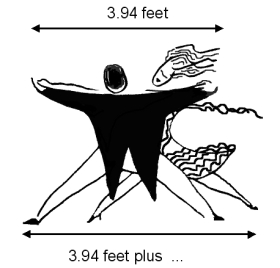
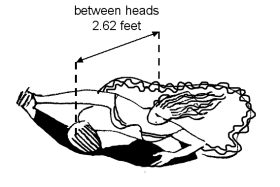
Photography and Dancesport.
Cameras pointed at dancers, flashes going off: a common thing accompanying even the smallest dancesport event.
Taking pictures of dancers is driven by several motivations:
taking souvenir shots,
documenting the performance for later analysis,
reporting on the event for press releases and club websites.
But everyone pointing a camera has one thing in common: everyone wants the best quality acchievable – simply because each event is unique,
never to be repeated.
In a series of articles ‘Ballroom’ will discuss selected issues of dancesport photography.
It helps to know this: the closer the focus is to the camera the smaller the Depth of Field.
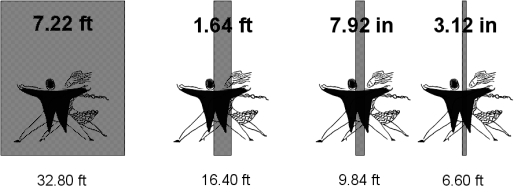
For a 70mm lens, mounted on a digital camera like a Canon EOS 40D and used in low light conditions with an aperture of f/2.8
the DOF is as follows:
| • | focused at 6.60 feet the depth of field is 3.12 inches! It would barely cover a face from tip of the nose to eyes and mouth. |
| • | focused at 9.84 feet the depth of field is about 7.92 inches, good for a face, frontal or in profile. |
| • | focused at 16.40 feet the depth of field is 1.64 feet, far away from a good shot of the pair. |
| • | only when focused at 32.80 feet the depth of field extends to 7.22 feet and accomodates the pair. |
It also helps to remember: lenses with shorter focal length produce larger Depth of Field.
The very often slandered point-and-shoot cameras like the Canon A590 have an enormous DoF which is due to the extremely short
focal length of the lenses.
A Canon A590 zoom at virtual ‘35mm’ which is a real focal length of 5.8mm and set to f/2.8 performs like this:
| • | focused at 6.60 feet it has already an incredible depth of field of 37 feet! |
| • | focused at 9.84, 16.40, or 32.80 feet it creates a depth of field which extends to infinity! |
It is a pity that these cameras perform poorly under low light conditions due to the tiny camera chips.
Corner shot, autofocus, and Depth of Field: a match not made in heaven.
A dancing pair moves fast. It will cross a zone of sharpness within seconds.
A pair moving towards the camera will stay in focus only for a moment or even less.
This is the reason why many corner-shot photographers permanently use the autofocus (AF).
Usually by tracking one of the faces the photographer tries to keep the dancers inside the zone of sharpness.
But what happens?
before the AF locks there is no chance to release the shutter.
A pair moving towards the camera rapidly reduces the distance forcing the AF to work really hard.
Together with additional technical workload (TTL measuring, flash recycling, picture processing and storing) it dramatically reduces the actual
shooting time and sometimes no picture at all is taken.
becoming more and more shallow while the dancers move towards the camera.
Even if the AF locks at 16.40 feet the Depth of Field is only 1.64 feet for a 70 mm lens at f/2.8
while an AF lock at 6.60 or 9.84 feet wouldn’t be useful at all.
Autofocus means to waste the available Depth of Field.
a portion in front of the object (towards the camera) and a portion behind the object in focus.
The photographer using the corner-shot method wants a lot of sharpness in front and doesn't care about sharpness behind the dancers.
But using AF means that the available sharpness is restricted to the DoF in front, towards the camera, which is very often
too small to accomodate the dancing pair, sometimes too shallow to accomodate anything useful at all.
usually giving a smaller zone in front of the object than behind the object! (This is especially true for larger zones of sharpness.)
The corner method shooter tracking his dancers with AF will always waste the larger zone of sharpness behind the pair while
having to cope with the smaller portion in front of the objects which is melting away rapidly while the dancers are moving towards
the camera.
A 70 mm lens with the AF locking at 16.40 feet on a face provides in reality no more than 10.20 inches of sharpness in front (plus whatever is
useful backwards).
Dancers rapidly moving towards the camera will pass through 10.20 inches of sharpness in a fraction of a second.
focused at 9.84 feet the frontal DoF is 1.67 feet.
At 16.40 feet the frontal DoF is 4.17 feet.
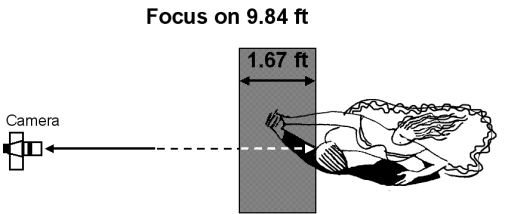
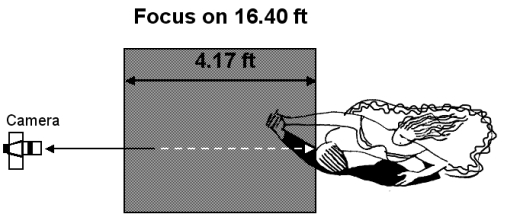
What the photographer wants:
| • | A large Depth of Field, accomodating a pair of dancers while they move. |
| • | To fully use the zone of sharpness, not only a small frontal portion. |
| • | Last not least: the time to take not only one but a couple of pictures. |
Focal length, aperture and current focus distance define the DoF.
Also a small aperture would make the depth of field larger.
But the bad light conditions in most ballrooms put a severe limit to smaller apertures.
No wonder that many of the satisfying pictures are taken at maximum apertures of f/2.8 or even larger with high ISO values.
Long distance shots are a good strategy since the depth of field increases with distance.
It’s a pity that light conditions
deteriorate rapidly with increasing distance due to the physics of reflected light.
Since short focal lengths produce a large Depth of Field a 28 mm lens is even at f/2.8 something that can
ease the photographer's burden.
The focal length of 28 mm is short enough to extend the Depth of Field.
Focused at 9.84 feet the depth of field is 4.20 feet, at 16.40 feet the DoF covers 12.66 feet.
And it is still possible to have sufficient light conditions.
Start to use the full Depth of Field: get rid of AF.
This is possible because focusing a lens doesn't necessarily mean to focus on the target, i.e. the dancers.
Focusing also doesn't mean to focus while you shoot.
Prefocus and set the lens instead:
| • | Just mark the DoF focus spot with someting like a chair. |
| • | Focus the lens on the chair and switch the it to ‘manual’ so it’s no longer reacting to AF. (Canon lenses have the M/AF-swtch on the lens body). |
If a 28 mm lens is set at 16.40 feet the Depth of Field ranges from 12.14 feet 24.90 feet.
Now remember a few marks in the ballroom which show you were the DoF starts and ends:
If the dancers are within the marks fire away –
you have a full zone of almost 13 feet of sharpness.
And since the AF is off there is less workload for the camera:
it becomes faster meaning you may squeeze in one or two additional shots!
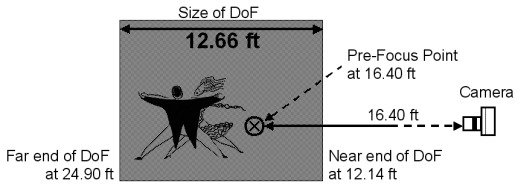
![]()
©: Ballroom Website, 2010
Aktualisiert: 29.09.2010

